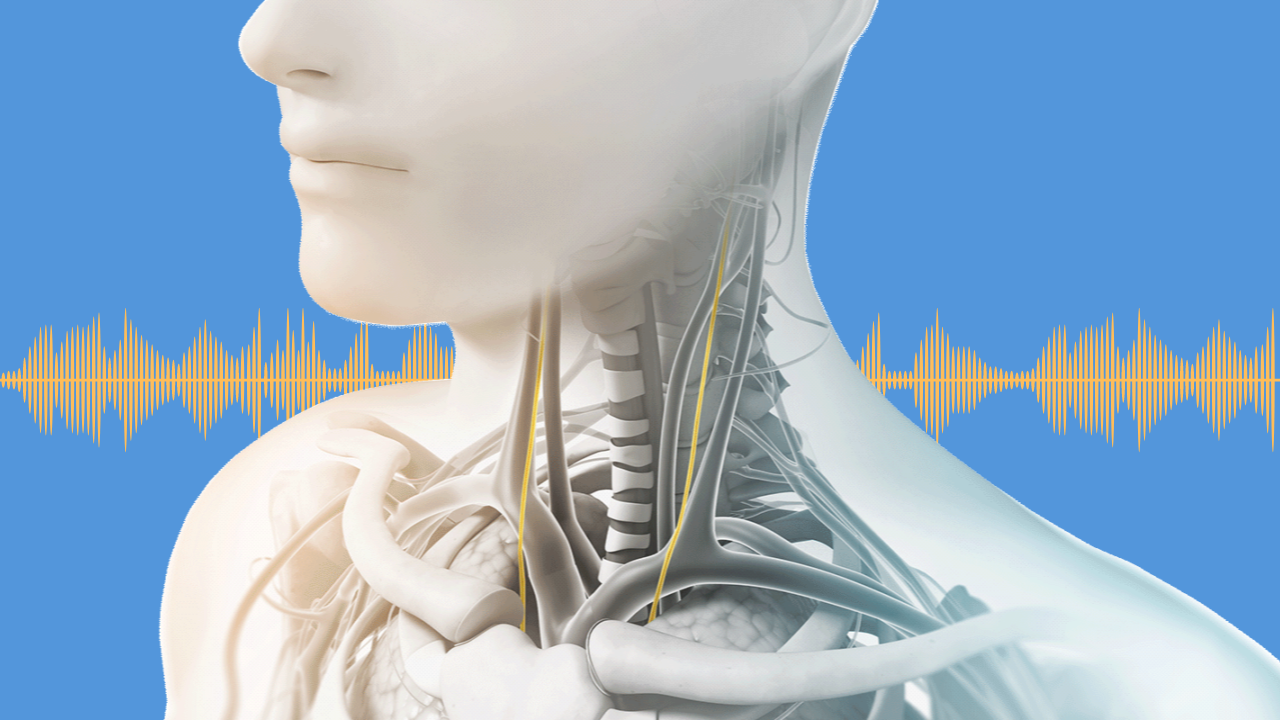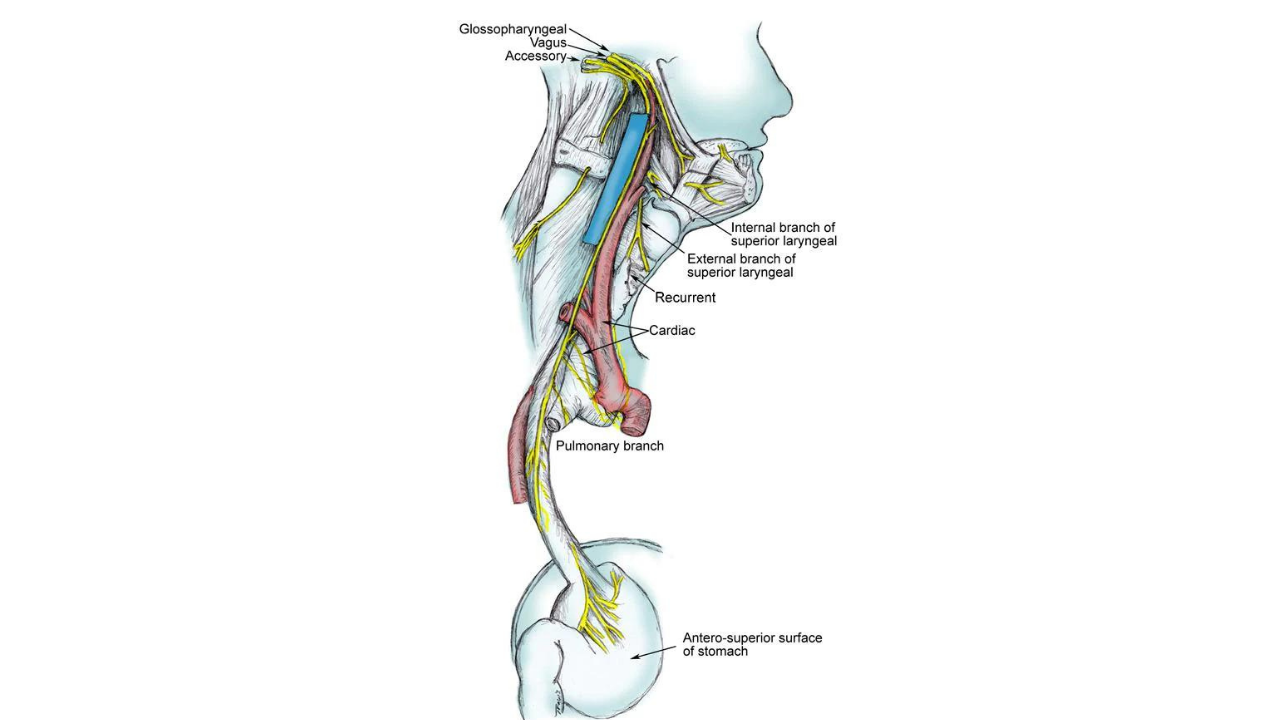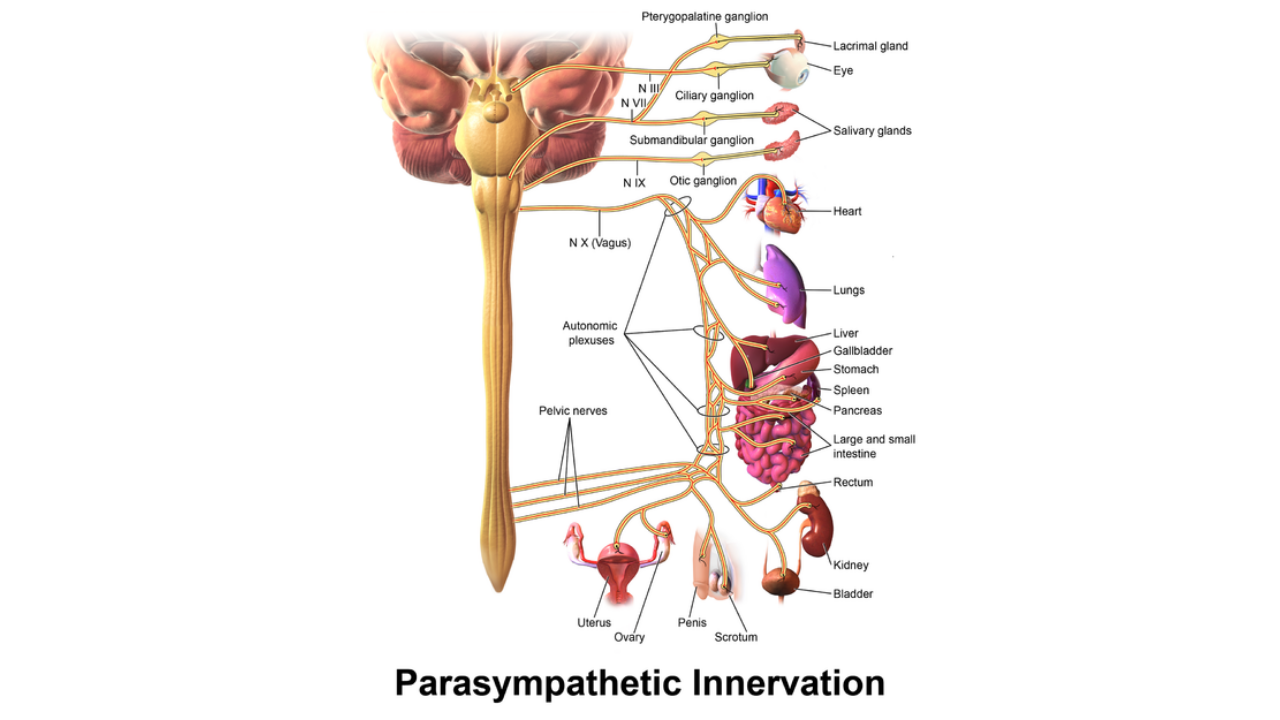Stimulating the Vagus Nerve for Better Sleep, Stress Relief & Health

Interacting with a hidden and often overlooked part of your body could hold the key to improving your relationship with sleep and stress.
I’m talking about stimulating the vagus nerve.
And learning how to make this simple practice a part of your daily life can help you do things like reduce inflammation, bounce back quicker from stress and even put you in a better mood!
That’s why I made this guide where I’ll share beginner friendly exercises to stimulate the vagus nerve, including one of my favorite techniques—sound based vagus nerve stimulation.
But first let’s take a look at a few vagus nerve basics.
What is the vagus nerve? Where does it originate?
Think of the vagus nerve as an elaborate pathway that connects the brain to the body where neurochemical information travels to and from the brain to the organs. It originates in the brain and travels throughout the neck and torso connecting each bodily system along the way.

Image source: Medscape: https://emedicine.medscape.com/article/1875813-overview
The vagus nerve is a vital part of your nervous system that helps regulate many functions of the body, including digestion, mood, breathing, heart rate, blood pressure and many others.

Image source: me-pedia.org
Stimulating the vagus nerve can also improve overall well being by reducing stress levels and improving sleep quality.
Though a complete discussion of the vagus nerve could fill a medical textbook, let’s shine a light on why leading researchers like Dr. Stephen Porges and major medical institutions like The Mayo Clinic and Johns Hopkins are promoting vagus nerve stimulation for self care.
🧐 Curious? Try This 12 Minute Sound Based Vagus Nerve Stimulation Tutorial Right Now For Free!
Why is the vagus nerve so important?
When it comes to your health, the importance of a “well toned” vagus nerve is paramount. That’s because high vagal tone—measured indirectly using heart rate variability— is seen most often in healthy people like elite athletes. Not only does their “stronger” vagal tone support performance that can seem “superhuman” to the rest of us, it also helps them to do so under intense stress.
This 2017 study shows how a sound based vagus nerve stimulation exercise positively affects vagal tone.
Additionally, high vagal tone has been connected with helping people recuperate from stress more quickly than those with low vagal tone.
Unfortunately, people who are ill also are often found to have low vagal tone.
The good news is that a regular vagus nerve stimulation practice may be able to help you solve some of your most nagging health challenges including:
- Being chronically stressed. (2019) Int J Yoga
- Becoming easily fatigued. (2018) J Tradit Complement Med.
- Enduring chronic pain. (2018) Natl.J.Maxillofac.Surg.
- Feeling unhappy. (2017) J Neural Transm
- Healing from trauma and PTSD (2019) Psychopharmacology
- Being able to relax and rest. (2022) Cleveland Clinic
As you stimulate the vagus nerve, it activates your parasympathetic nervous system and helps you generate natural “feel good chemicals” including:
Acetylcholine: your body’s most abundant neurotransmitter that serves as a natural tranquilizer and inflammation suppressant. It also regulates our arousal response.
Dopamine: a neurotransmitter that helps control the brain’s reward and pleasure centers.
Endorphins: chemicals produced naturally in the body to cope with pain or stress. These neuropeptides are known for their morphine-like euphoric effect.
Nitric oxide: known for its anti-inflammatory effect and its ability to relax the inner muscles of the blood vessels, causing them to widen and increase circulation.
Oxytocin: a social bonding hormone known for creating a feeling of well-being.
Now that we’ve covered some basics, let’s dive into exercises and techniques for stimulating the vagus nerve.
How Can You Stimulate the Vagus Nerve?
There are several methods of vagus nerve stimulation.
Of course, pharmaceutical companies are touting effective, but costly hand-held devices ($598/month on average) that involve using an electrical current applied to the skin.
 Photo https://spectrum.ieee.org/vagus-nerve
Photo https://spectrum.ieee.org/vagus-nerve
Another method uses a surgically implanted device under the skin called a vagus nerve stimulator (VNS). This is an option often used for people with treatment resistant epilepsy.
For some people, using devices or having surgery is the right choice. And of course, you should always consult with your doctor for any health related issues, medical questions and before trying any of the exercises below.
But what about a vagus nerve stimulation exercise you can do at home? Here’s a full collection you can start right now.
12 Vagus Nerve Exercises for Better Sleep, Stress Relief & Health
- 2:1 Deep Abdominal Breathing for Stimulation of Vagus Nerve. As you're preparing for sleep, inhale through your nose for a count of 3 so that your belly fills with air. Then exhale through your mouth with pursed lips slowly for a count 6. Essentially, you're exhaling twice as long as you inhale. Adjust the timing of the count to make it comfortable for you. Repeat until you feel deeply relaxed. (2018) Cureus
- Brain Humming: Breathe in. Keep your back molars gently together, keep your lips closed and exhale a gentle humming sound for a full breath. Don’t worry about being in tune! Repeat until calm. Here's one of my best 12 minute tutorials that will teach you a potent sound based vagus nerve stimulation sequence. (2017) Int J Yoga
- Cold water/ice: Splash your face with very cold water 3-10 times. Slowly turn on colder water in the shower. Put a cold pack on your chest. Doing so helps wake up the nervous system and may strengthen vagal tone. (2008) Aviat Space Environ Med.
- Gargle: The act of gargling will stimulate the vagus nerve connected to your vocal cords. Start with 10 seconds each time you have a glass of water and gradually work your way up to 30 seconds. (2020) J Voice
- Sing on your own: Even if you can’t carry a tune in a bucket, singing stimulates the vagus nerve near your vocal cords. No matter what anyone has told you about your voice, it’s your right to use it to feel good! Start by humming along or even belting out your three favorite songs per day and notice how it makes you feel. Whether you’re “in tune” or not, you’ll still get the same benefits from stimulating your vagus nerve. (2022) Neuromodulation Of course, if singing isn't your thing, just try some simple brain humming.
- Sing with others: Connecting socially with others benefits the health of your vagus nerve and your overall well being by activating the bonding hormone oxytocin while also all the benefits of vagus nerve stimulation. (2017) Front Hum Neurosci
- Yoga: Take a live or online yoga class to boost overall nervous system health while boosting resilience to stress. (2018) Front Hum Neurosci
- Exercise: Brain experts regularly tout exercise as one of their top ways to boost brain health. Not only that, but it’s also been shown to stimulate the vagus nerve. (2017) Psychology Today
- Laugh: Watch your favorite comedian or funny movie and let the laughs roll! Doing so can stimulate the vagus nerve while also producing the anti inflammatory chemical nitric oxide. (2009) Med Hypothesis
- Sleep on your right side: You can literally do this one in your sleep! Lying on your right side has been shown to increase heart rate variability and stimulate the vagus nerve. This study shows how sleeping on your right side helps people with coronary artery disease. (2008) Circ J.
- Surround yourself in beauty: Watching the sunrise or sunset, taking a walk near trees or water, looking at beautiful art or even turning on nature videos all help generate a positive state of mind, which helps to improve vagal tone. (2013) Psych Sci.
- Hang out with your pet: Spending time with animals has been shown to induce calm, happiness (2019) J Am Psychiatr Nurses Assoc. And to positively affect heart rate variability—a key indicator of vagus nerve health. (2019) Int J Environ Res Public Health
In conclusion, the vagus nerve is important because it affects many different parts of our body. By stimulating the vagus nerve, you can improve sleep quality, reduce stress levels, and even overall well being.
Even though life feels stressful right now, remember to tap into your body’s built-in tools to help keep yourself in balance.
The more you practice these techniques, the better and faster they’ll work—especially when you, or a loved one, need them the most.
Be Well,
Jim
P.S. Not sure where to start? Get one of my most effective sound based vagus nerve stimulation tutorials right now for free.
🧐 Curious? Try This 12 Minute Sound Based Vagus Nerve Stimulation Tutorial Right Now For Free!
FDA Compliance: The information on this website has not been evaluated by the Food & Drug Administration or any other medical body. We do not aim to diagnose, treat, cure or prevent any illness or disease. Information is shared for educational purposes only. You must consult your doctor before acting on any content on this website, especially if you are pregnant, nursing, taking medication, or have a medical condition.
The material provided on this site is for educational purposes only and any recommendations are not intended to replace the advice of your physician. You are encouraged to seek advice from a competent medical professional regarding the applicability of any recommendations with regard to your symptoms or condition.
Copyright © 2021-2022 by Blue Beat Media. Thank you for your interest in Jim Donovan / Jim Donovan Music. We do not allow republication of our full newsletters and articles. However, you can post a portion (no more than 90 words, 1-2 paragraphs) of our content with a live link back to our homepage, donovanhealth.com, or a link to the specific article you are quoting from.
About the author:
Jim Donovan M.Ed. is a multi-platinum musician, educator and TEDx speaker.
His mission is to share the restorative power of music through education and performance.
Donovan is an Assistant Professor and Director of Music and Wellness at Saint Francis University.
His viral TEDx Talk "How to Trick Your Brain Into Falling Asleep" has been viewed over 6 million times to date.
He currently performs with his band The Sun King Warriors who can best described as as a blend of rhythm heavy roots rock, with a strong dose of big barreling drums.
Jim Donovan got his start as a founding member of the multi-platinum selling band Rusted Root.
There he co-wrote the song “Send Me on My Way” featured in the movies "Ice Age", "Matilda" and the Netflix series "New Girl".
During his time with the band 1990-2005, he recorded and released seven full length albums. Including "When I Woke" (3x platinum).
He also had the honor of sharing the stage with many of his musical influences and heroes including Robert Plant and Jimmy Page of Led Zeppelin (1995 US/UK tour), Carlos Santana (1997/2002 US tour), The Allman Brothers Band (1995/96 US tour), The Grateful Dead (1995 Three Rivers Stadium in Pittsburgh, PA) and many others.
Send Me On My Way also became the first song on Mars where it “woke up” NASA’s Mars Rover.


